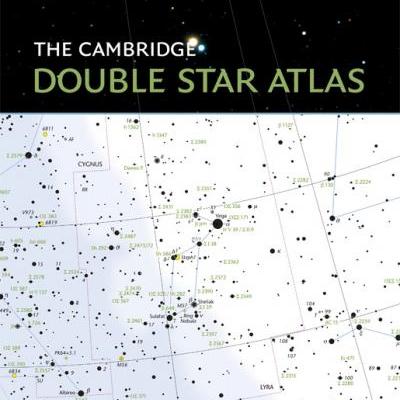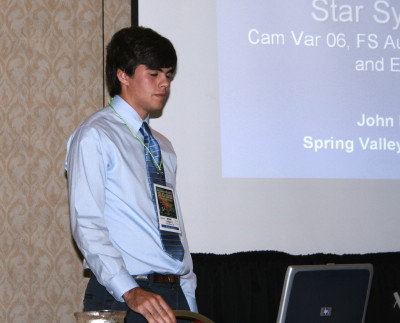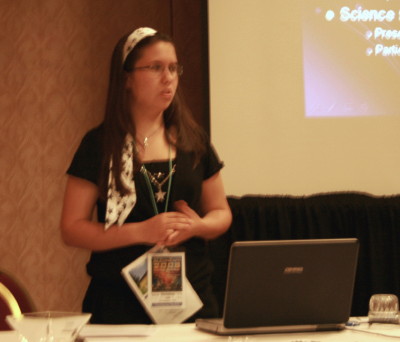The Jack Horkheimer Award is presented to any Astronomical League member under the age of 19 on the date of the application. The Award is based upon service to the League, either directly or through service to any Astronomical League society. Service could be in the form of educational outreach, knowledge and skills at public star parties or other astronomical service. Young astronomers can apply for both the National Young Astronomer Award and the Horkheimer Award. These criteria also apply to the Horkheimer/Parker as well as the Horkheimer/D’Auria Award listed below.
The winner of the Horkheimer/Smith Award will receive an expenses-paid trip to the Astronomical League Convention, a plaque presented at the convention’s awards banquet and a $1,000 cash prize. In addition, for the past several years, Celestron, Inc. has donated one of its fine telescopes to the Horkheimer winner.
Dr. Parker is a past director of the Association of Lunar and Planetary Observers (A.L.P.O.) and currently serves on the Board of that organization. He has been an A.L.P.O. Mars Section Coordinator since 1977, and has done extensive research on the climate and meteorology of Mars. 2008 is his 53
rd year of observing Mars.
Parker has authored or co-authored over 150 papers on the Solar System and on planetary photography. These have been published in both amateur and professional journals, such as Science, Nature, Icarus, The Astronomical Journal, and The Journal of Geophysical Research. Parker’s photographs and electronic images of the planets have appeared in numerous books and magazines throughout the world, including Encyclopedia Britannica’s 1996 Science and the Future. He is co-author of the book Introduction to Observing and Photographing the Solar System.
In recognition of his contributions to planetary astronomy, Dr. Parker was honored by the International Astronomical Union in 1994, when an asteroid was given the name “5392 Parker.” In 2004 he was awarded the Oriental Astronomical Association’s Gold Medal for his work on Mars.
The winner of this award will receive a plaque and a $1,000 cash prize.
This award is named in honor of Matthew (Tippy) D’Auria.Tippy is an electronics engineer and has a degree in Electronic Engineering Technology, and a degree in Computer Integrated Manufacturing. He has been an active astronomer since 1980. He is the founder of the Winter Star Party, which is sponsored by the Southern Cross Astronomical Society. In June 2001, Tippy joined an elite group of some of the world’s best planetary astronomers on a mission to record a predicted flash on the red planet … flashes that may be reflections from ice or other highly reflective land features on Mars in a region called Edom. In the astronomical community, such phenomena are typically met with skepticism; however the brightening effect on Edom occurred as predicted and was recorded by Tippy D’Auria along with Dr. Donald C. Parker through a Meade 12″ LX200 scope on video. It appears that it is the only existing video sequence of this event, which made the IAU circulars and headlines throughout the global astronomical community.
In January 2001, Tippy received recognition for his contributions to amateur astronomy, as he was honored by the International Astronomical Union, when an asteroid was given the name “11378 DAuria.”
In April 2001, he led an expedition to the volcanoes of Costa Rica, to film a National Geographic documentary called “The Volcano Hunters.”
In August 2007, Tippy received the Astronomical League Award for his many contributions to the astronomical community. In February 2008, he received an Astronomy Outreach Award – in recognition for his contributions in outreach and public education in astronomy.
The winner of this award will also receive a plaque and a $1,000 cash prize.
How to make nominations for the Horkheimer/Smith, Horkheimer/Parker and Horkeimer/ D’Auria Awards:
The vice president of the Astronomical League will chair the award committee. The chair will select at least three judges who have previously been affiliated with the Astronomical League. The president of the Astronomical League will approve the selected judges.
The deadline for applying for the next Horkheimer Service Award is April 10, 2009. The 2009 application form is available on the League’s website at
www.astroleague.org. More specific information is found on the application form. The same application is used for all three awards. If you have any young astronomers who have provided service to your society or who are talented observers, please contact Vice President Carroll Iorg at
Carroll-Iorg@kc.rr.com for more information or an application form.
Youth Journalism Award:
Horkheimer/ O’Meara Award:
This new award is named in honor of Stephen and Donna O’Meara.
Donna’s Bio:
Donna O¹Meara is an award-winning children’s author, National Geographic Contract Photographer/Videographer/Explorer, volcano expert and experienced student lecturer (Grades K-12). Donna O’Meara has served as a female scientist role model for over two decades to a generation of children learning about Earth’s volcanic
and other natural wonders. O’Meara has worked her lifetime getting
young people interested in natural science, Earth’s most remote and fragile
environments and volcanoes. O’Meara has blazed a vast scientific trail as
cited by City Smart Magazine. She was chosen in September 2007 as an
”outstanding woman who is changing the world” and as a National Geographic Funded Volcano Explorer.
Stephen’s Bio:
Steve O’Meara earned a Bachelor of Science degree from Northeastern University. He has spent much of his career on the editorial staff of Sky & Telescope, is new a columnist and contributing editor for Astronomy magazine, and has authored or coauthored 10 books on diverse subjects: astronomy, volcanoes, and scary science for youngsters.
The Texas Star Party (TSP) gave him its highest honor, the Lone Stargazer Award, “for setting the standard of excellence in visual observing.” The TSP also gave him its Omega Centauri Award for “advancing astronomy through observation, writing, and promotion, and for sharing his love of the sky,” and the International Astronomical Union named asteroid 3637 O’Meara in his honor. He has also been awarded with the Caroline Herschel Award for his greatest achievements.
Among his many astronomical achievements, he was the first to sight Halley’s Comet on its 1985 return; he noticed the dark “spokes” in Saturn’s B ring before the Voyager 1 spacecraft imaged them; and he was the first person to determine the rotation period of the distant planet Uranus.
Steve enjoys traveling the world with his wife, Donna, to document volcanic eruptions. National Geographic Explorer produced a movie (“Volcano Hunters”) about the O’Mearas’ research; the film was selected as one of the year’s best National Geographic documentaries and won the Fall 2002 Golden Eagle Award for excellence in documentary. Steve is also a dynamic lecturer on astronomy and volcano topics. He is also a contract videographer for National Geographic Digital Motion and a contract photographer for National Geographic Image Collection.
This competition for the Horkheimer/O’Meara Youth Journalism Award is open to young writers in the 8-14 age groups. The submission should be 300 to 500 words we are not limiting the entries to astronomy-related topics. We are open to any science-related topic that interests the contestant –– from robin’s eggs to quasars. What we are looking for is someone who can take a factual scientific event or discovery and write an accurate story that is so exciting and informative that readers will not want to put it down, they are learning so much. Aside from accuracy, entries will be judged on three criteria: creativity, conciseness, and clarity.
The winner will win a plaque and a $1,000 cash prize.
How to make nominations for the Horkheimer/ O’Meara Award:
Entries should be sent either in writing to the O’Mearas, P. O. Box 218, Volcano, HI 96785, or via Email:
donna@post.harvard.edu.
The deadline is April 10, 2008







 Thanks to the continuing generosity of Jack Horkheimer, four awards are now part of the Astronomical League’s Jack Horkheimer youth award program, including a youth journalism award. The former Jack Horkheimer award has been renamed the Horkheimer/Smith Award.
Thanks to the continuing generosity of Jack Horkheimer, four awards are now part of the Astronomical League’s Jack Horkheimer youth award program, including a youth journalism award. The former Jack Horkheimer award has been renamed the Horkheimer/Smith Award. 
 Shown at the left is John Hodge II, the 2008 National Young Astronomer Award winner who is giving the audience details of his project. John created and analyzed light curves of catclysmic variable star systems. In the fall of 2005 he used a 12 inch Meade LX200 telescope and ST7 CCD camera to obtain his images. The following year he did a more detailed study using different stars and a more complex mathematical analysis.
Shown at the left is John Hodge II, the 2008 National Young Astronomer Award winner who is giving the audience details of his project. John created and analyzed light curves of catclysmic variable star systems. In the fall of 2005 he used a 12 inch Meade LX200 telescope and ST7 CCD camera to obtain his images. The following year he did a more detailed study using different stars and a more complex mathematical analysis.
 Christine Lee, The 2008 Jack Horkheimer Award winner, is making a presentation about the “Galaxy Zoo” program at this years ALcon. Christine is a volunteer for the Galaxy Zoo project which is classifying millions of galaxies obtained with Sloan Deep Sky Survey telescope. She is a member of the Rose City Astronomers in Portland, Oregon. Christine is a very active club member who has made presentations about science, astrophysics, galaxies, and other science topics. She is currently grinding a 6 inch mirror at a club workshop.
Christine Lee, The 2008 Jack Horkheimer Award winner, is making a presentation about the “Galaxy Zoo” program at this years ALcon. Christine is a volunteer for the Galaxy Zoo project which is classifying millions of galaxies obtained with Sloan Deep Sky Survey telescope. She is a member of the Rose City Astronomers in Portland, Oregon. Christine is a very active club member who has made presentations about science, astrophysics, galaxies, and other science topics. She is currently grinding a 6 inch mirror at a club workshop.